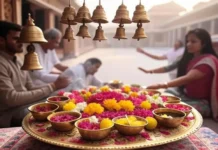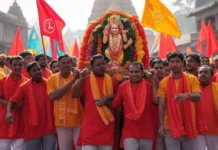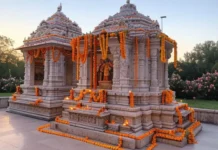Vasant Panchami is a vibrant and significant festival celebrated in India, marking the arrival of spring and paying homage to Goddess Saraswati, the deity of wisdom, learning, music, and arts. This auspicious day falls on the fifth day of the bright half (Shukla Paksha) of the month of Magha in the Hindu calendar, which usually coincides with late January or early February. Vasant Panchami is not just a celebration of the season but also a day to seek blessings for knowledge and enlightenment.
In 2025, this vibrant festival will be celebrated on Sunday, February 2. The day will be particularly auspicious for worshiping Goddess Saraswati, with the Saraswati Puja being observed between 7:09 AM and 12:35 PM, lasting for 5 hours and 26 minutes, according to Drik Panchang.
This festival is a joyful occasion celebrated across India, especially in the northern and eastern regions. The color yellow plays a central role in the celebrations, symbolizing the arrival of spring and the vibrancy of life. Vasant Panchami also emphasizes knowledge, learning, and artistic expression, making it a significant day for students, artists, and musicians alike.
let’s explore the history, rituals, and regional significance of Vasant Panchami, along with how this day is celebrated and its connection to renewal and enlightenment.
Key Details
| Event Name | Vasant Panchami |
|---|---|
| Date | Sunday, February 2, 2025 |
| Auspicious Timing | Saraswati Puja: 7:09 AM to 12:35 PM (Duration: 5 hours, 26 minutes) |
| Significance | Marks the arrival of spring and worship of Goddess Saraswati, goddess of wisdom |
| Main Rituals | Prayers to Goddess Saraswati, wearing yellow, kite flying, and cultural events |
| Popular Foods | Panchami sweets, saffron rice, mawa kachori, and kesar halwa |
| Celebrated By | Hindus, particularly in North and East India |
| Theme | Renewal, wisdom, creativity, and knowledge |
The Origin and Significance of Vasant Panchami
Vasant Panchami has deep cultural roots in Indian tradition, primarily connected with the arrival of spring. The festival signifies new beginnings and the end of the cold winter. The yellow mustard flowers, which bloom during this time, symbolize the freshness and vibrancy of the season.
1. Worship of Goddess Saraswati
At the core of Vasant Panchami is the worship of Goddess Saraswati, revered as the goddess of knowledge, wisdom, and the arts. On this day, devotees place their books, musical instruments, and even tools for creative work in front of the goddess to seek her blessings for success in their intellectual and artistic endeavors.
2. The Symbolism of Yellow
Yellow is the dominant color of the day. It represents the warmth of the sun, the vibrancy of nature, and the promise of new growth. From wearing yellow clothes to decorating homes and temples with yellow flowers, the color is symbolic of prosperity and enlightenment. Many people also prepare food items in yellow, such as saffron rice and kesar halwa (saffron-flavored sweet).
3. Seasonal Change and Renewal
Vasant Panchami is a time for renewal, not just of nature but of the spirit. The end of winter gives way to the warmth of spring, which brings with it new opportunities for growth, learning, and creativity. The festival invites individuals to refresh their minds and souls, fostering an environment for knowledge to bloom.
Rituals and Celebrations of Vasant Panchami
On Vasant Panchami, people partake in various customs and rituals that are both cultural and spiritual.
1. Saraswati Puja
The most important ritual is the Saraswati Puja. During the auspicious period between 7:09 AM and 12:35 PM, devotees offer prayers to Goddess Saraswati in homes, schools, and temples. People place their books, pens, and musical instruments on the altar to seek her blessings for knowledge and success. This puja is especially important for students and anyone pursuing intellectual or artistic work.
2. Dressing in Yellow
Yellow symbolizes the energy of spring, and on this day, people wear yellow clothes to celebrate the arrival of the season. It is also common to see yellow flowers, such as marigolds, being used for decorations during the puja.
3. Kite Flying
In several regions, especially in Gujarat, Rajasthan, and Punjab, kite flying is a beloved tradition on Vasant Panchami. As the day is typically bright and sunny, it provides the perfect conditions for this fun and lively activity. Kites of all sizes fill the sky, adding to the joy and exuberance of the festival.
4. Special Foods and Sweets
Vasant Panchami is also a time for feasting. Traditional sweets like kesar halwa (saffron sweet) and mawa kachori are prepared and shared among friends and family. The yellow foods symbolize the color of spring and the harvest season, further reinforcing the themes of renewal and prosperity.
Regional Celebrations of Vasant Panchami
Vasant Panchami is celebrated with slight variations across different parts of India:
1. Bengal
In Bengal, the festival is known as Saraswati Puja, and it is widely celebrated in schools and colleges. Students place their books in front of the goddess to seek blessings for success in their studies. Cultural performances, including classical music and dance, are organized to honor the goddess’s connection with the arts.
2. Punjab and Haryana
In Punjab and Haryana, the day is also associated with the harvest season, and people celebrate the agricultural aspects of the festival. Communities gather for traditional songs and dances, and meals are prepared with the first harvest. Yellow mustard flowers are a key symbol of the day.
3. Gujarat and Rajasthan
In these states, the primary highlight of the festival is kite flying. The clear skies and pleasant weather make it the perfect opportunity for flying kites, and the day is filled with vibrant colors and excitement as people compete to cut each other’s kites in the sky.
Vasant Panchami is not just a celebration of spring, but also a time to seek blessings for knowledge, creativity, and intellectual growth. Whether through Saraswati Puja, kite flying, or indulging in special foods, this festival serves as a reminder of the importance of learning and personal development. As we celebrate the arrival of spring and the renewal of nature, Vasant Panchami encourages us to embrace new opportunities and seek wisdom in all aspects of our lives.





























